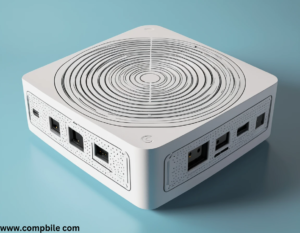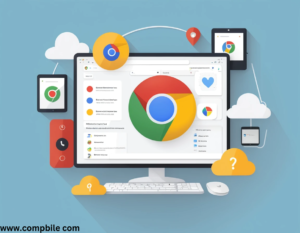Key Features of a Chromebox
Compact Design
- Chromebox ⇒ Chrome boxes are small, lightweight, and portable, often resembling a mini PC or set-top box.
- They take up minimal space and can be easily mounted behind a monitor or placed on a desk.
Chrome OS:
- Runs Chrome OS, which is optimized for web-based tasks and cloud computing.
- Supports Android apps and Linux applications (on newer models).
Performance:
- Typically uses low-power processors (Intel Celeron, Core i3/i5, or ARM-based chips).
- Designed for fast boot times and smooth performance for web browsing, video streaming, and light productivity tasks.
Security:
- Chrome OS is known for its robust security features, including automatic updates, sandboxing, and verified boot.
- Less susceptible to viruses and malware compared to traditional operating systems.
Connectivity:
- Includes multiple USB ports, HDMI/DisplayPort, and sometimes Ethernet for wired internet.
- Supports Bluetooth and Wi-Fi for wireless peripherals and internet access.
Use Cases:
- Ideal for home users, businesses, education, and digital signage.
- Great for web browsing, video conferencing (e.g., Google Meet, Zoom), and running cloud-based apps like Google Workspace.
Popular Chromebox Models
ASUS Chromebox:
- Known for its sleek design and reliable performance.
- Offers models with Intel Core processors for better performance.
Acer Chromebox:
- Affordable and compact, suitable for basic tasks and business use.
HP Chromebox:
- Focuses on business and enterprise use, with robust build quality and security features.
Dell Chromebox:
- Designed for enterprise environments, with manageability and security features.
Google Chromebox (discontinued):
- Google previously offered its own Chromebox but has since shifted focus to Chromecast and other devices.
Advantages of a Chromebox
- Affordability: Generally cheaper than traditional desktops or laptops.
- Ease of Use: Simple setup and user-friendly interface.
- Low Maintenance: Automatic updates and minimal need for technical support.
- Energy Efficiency: Consumes less power than traditional desktops.
Limitations of a Chromebox
- Limited Offline Functionality: Heavily reliant on internet connectivity.
- Hardware Limitations: Not suitable for resource-intensive tasks like gaming or video editing.
- Software Compatibility: Primarily designed for web apps; limited support for traditional desktop software.
Who Should Buy a Chromebox
- Casual Users: For web browsing, streaming, and light productivity.
- Businesses: For kiosks, digital signage, or office workstations.
- Schools: Affordable and easy-to-manage devices for students.
- Developers: For testing web apps or running Linux environments.
History of Chrome boxes
- 2012: Chrome boxes were introduced as part of Google’s push to expand Chrome OS beyond Chromebooks. The first Chromebox was released by Samsung.
- 2014: Major manufacturers like ASUS, HP, and Dell began producing Chrome boxes, targeting both consumers and businesses.
- 2016-2020: Chrome boxes gained popularity in enterprise and education sectors due to their affordability, security, and ease of management.
- 2021-Present: Chrome boxes now support Android apps and Linux containers, making them more versatile for developers and power users.
Technical Specifications
Chrome boxes vary in specs depending on the manufacturer and model, but here’s a general breakdown:
Processor:
- Entry-level: Intel Celeron or ARM-based chips.
- Mid-range: Intel Core i3 or i5.
- High-end: Intel Core i7 (rare, mostly for enterprise use).
RAM:
- Typically 4GB to 16GB, with 8GB being the sweet spot for most users.
Storage:
- Usually 32GB to 256GB of eMMC or SSD storage. Most data is stored in the cloud, so local storage is less critical.
Ports:
- USB-A and USB-C ports.
- HDMI and/or DisplayPort for external monitors.
- Ethernet, audio jack, and SD card slots (on some models).
Connectivity:
- Wi-Fi (802.11ac or Wi-Fi 6 on newer models).
- Bluetooth for peripherals like keyboards and mice.
Operating System:
- Chrome OS, with automatic updates and support for Android apps and Linux (via Crostini).
Use Cases for Chrome boxes
Home Use
- Web browsing, streaming videos, and light gaming (via Android apps or cloud gaming services like GeForce NOW).
- Great as a media center when connected to a TV.
Business and Enterprise:
- Ideal for office workstations, especially for companies using Google Workspace or other cloud-based tools.
- Used in call centers, kiosks, and digital signage due to their compact size and low maintenance.
Education:
- Affordable and easy to manage for schools and classrooms.
- Supports Google Classroom and other educational tools.
Developers:
- Can run Linux applications, making it a budget-friendly option for coding and testing web apps.
Gaming:
- While not designed for gaming, Chrome boxes can stream games via services like Google Stadia (before its shutdown) or NVIDIA GeForce NOW.
How to Choose the Right Chromebox
Identify Your Needs:
- Basic tasks (web browsing, streaming): Entry-level models (Intel Celeron, 4GB RAM).
- Business or multitasking: Mid-range models (Intel Core i3/i5, 8GB RAM).
- Developers or power users: Models with Linux support and higher specs.
Consider Connectivity:
- Ensure it has the ports you need (USB-C, HDMI, etc.).
- Check for Wi-Fi 6 or Ethernet if you need fast internet.
Check for Updates:
- Chrome boxes receive updates for about 6-8 years from their release date. Make sure the model you choose is still supported.
Look for Deals:
- Chrome boxes often go on sale, especially during back-to-school or holiday seasons.
Top Chromebox Recommendations
ASUS Chromebox 4:
- Intel Core i3/i5, up to 16GB RAM, 128GB storage.
- Great for business and home use.
Acer Chromebox CXI5:
- Intel Core i5, 8GB RAM, 128GB SSD.
- Affordable and reliable for everyday tasks.
HP Chromebox G3:
- Intel Core i3, 8GB RAM, 64GB storage.
- Designed for enterprise use with robust security features.
CTL Chromebox CBx2:
- Intel Celeron, 4GB RAM, 32GB storage.
- Budget-friendly option for basic tasks.
Alternatives to Chrome boxes
Mini PCs:
- More powerful and versatile, running Windows or Linux.
- Examples: Intel NUC, Lenovo Think Centre Tiny.
Mac Mini:
- High-performance desktop for creative professionals.
- Runs macOS, but more expensive.
Raspberry Pi:
- Ultra-affordable and customizable for hobbyists and developers.
- Limited performance compared to Chrome boxes.
Chromebooks:
- If portability is important, consider a Chromebook instead of a Chromebox.
Tips for Getting the Most Out of Your Chromebox
Use Cloud Storage:
- Take advantage of Google Drive or other cloud services to save space on your device.
Explore Android Apps:
- Install Android apps from the Google Play Store to expand functionality.
Enable Linux:
- For developers, enable Linux support to run coding tools and other applications.
Connect to Multiple Monitors:
- Many Chrome boxes support dual monitors, making them great for productivity.
Keep It Updated:
- Chrome OS updates automatically, but ensure your device is connected to the internet regularly.
Advanced Chrome OS Features on Chrome boxes
Chrome boxes benefit from the full range of Chrome OS features, which have evolved significantly over the years. Here are some advanced features you might not know about:
Linux (Crostini) Support:
- Chrome boxes can run Linux applications in a secure container.
- Ideal for developers who want to use tools like VS Code, Python, or Docker.
- Enable it in Settings > Developers > Linux Development Environment.
Android App Support:
- Access millions of Android apps via the Google Play Store.
- Great for apps like Microsoft Office, Adobe Lightroom, or mobile games.
Virtual Desks:
- Organize your workspace with multiple virtual desktops.
- Switch between tasks seamlessly using the Overview key or trackpad gestures.
Chrome Enterprise Upgrade:
- Businesses can upgrade to Chrome Enterprise for advanced management tools, including remote support, kiosk mode, and detailed analytics.
Cloud Gaming:
- Use cloud gaming services like NVIDIA GeForce NOW or Xbox Cloud Gaming to play AAA games on your Chromebox.
Guest Mode and Multiple Users:
- Easily share your Chromebox with others without compromising your data.
- Guest mode ensures no data is saved after the session ends.
Offline Mode:
- Certain apps (like Google Docs) can work offline, syncing your changes when you reconnect to the internet.
Enterprise Use Cases for Chrome boxes
Chrome boxes are increasingly popular in business environments due to their affordability, security, and ease of management. Here’s how they’re being used:
Digital Signage:
- Chrome boxes power digital displays in retail stores, airports, and restaurants.
- Easy to manage remotely using Chrome Device Management.
Call Centers:
- Affordable and secure workstations for agents using cloud-based CRM tools.
Kiosks:
- Used in libraries, museums, and government offices for self-service terminals.
- Kiosk mode locks the device to a single app or website.
Remote Work:
- Chrome boxes are great for remote workers who rely on cloud-based tools like Google Workspace or Microsoft
Get article on pdf file… click now
…………….Chromebox……………….







